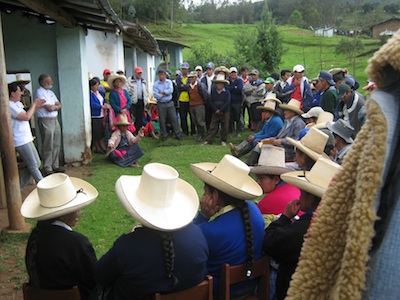Providing energy access to remote rural communities
In Latin America around 34.5 million people are excluded from the electricity service. The majority of them are living in poor, rural and isolated communities, such as the indigenous populations. They are not only excluded from access to the electric service, but also from future plans of grid extension, because of their low energy needs, the dispersion and difficult access of their dwellings, ecc.
Within this framework, the Luz en Casa (Light at Home) Programme was started in Peru to demonstrate that rural electrification through renewable energy is technically feasible, economically sustainable, and affordable to users. Nowadays, another programme called Luz en Casa Oaxaca is being started in Mexico, driven by an innovative development partnership which actively involves authorities and the private initiative.
The Huatulco Biosphere Reserve and some World Heritage properties, such as the Historic Centre of Oaxaca and Archaeological Site of Monte Alban, and the Prehistoric Caves of Yagul and Mitla in the Central Valley of Oaxaca, are in the Mexican scope of action of this programme.
LUZ EN CASA – CAJAMARCA, PERU.
Photo Gallery operates in isolated and scattered communities of the Northern Mountains of Cajamarca, on the Andes. This programme demonstrates the success of rural electrification by means of photovoltaic technology. It uses a delivery model based on the installation and operation of Solar Home Systems (SHS), with a project management that involves the beneficiaries and the collection of a service- fee. This model has been implemented since 2009 by the non-profit small company ACCIONA Microenergia Peru (AMP).
AMP is a regulated electricity provider that supplies basic electricity services to low-income people, within a regulatory framework that allows affordability for those users. In Peru there is a solidarity fund that finances access to electricity for people of little or no income. Therefore this fund allows Luz en Casa ’s beneficiaries to pay only a monthly fee of S/.10 (around 3.5 US$) for operation and maintenance services, as well as AMP to access to the revenues, around S/.30 (oppure 10.5 US$) by each user, making it economically sustainable, being their current operational cost of 3,000 SHS.
Providing electricity to these communities prevents health hazards that arise from the use of candles and kerosene, such as lung and eye disorders, and safety risks like fires- It also favours the extension of the working day for educational or productive purposes. Those SHS give four hours of efficient lighting and access to electronic devices, such as TV or radio. Their purchase and installation had been financed through ACCIONA Corporation’s donations (1,300 sistemi 2010 e 2012), and a BID-FOMIN’s long-term credit (1,700 sistemi 2013).
Tuttavia, beneficiary engagement is the cornerstone of the development of the Luz en Casa Programme. It is the user who makes the decision to participate in the programme, paying for the offered service and being trained to use and maintain the SHS appropriately. Beneficiaries also participate as members in the Photovoltaic Electrification Committees, the community body in charge of communicating with AMP, collecting fees, and maintaining preventively the SHS.
Inoltre, beneficiaries’ engagement has made possible the start of new related projects, such as electrification of community centres (scuole, churches…), at the communities’ request in the localities where the programme operates, or training beneficiary people to become local technicians in installation and maintenance of PV systems. In short, capacity building has been developed in the communities involved.
LUZ EN CASA OAXACA (MÉXICO)
Gli Photo Gallery Oaxaca Programme started in 2012 in order to give access to electricity basic services to 9,500 households of Oaxaca. Oaxaca is one of the Mexican States with a severe lack of access to basic services, having more than 800 communities with less than 100 inhabitants without access to electricity and without plans to be electrified.
The delivery model of Luz en Casa Oaxaca is different from the first Luz en Casa programme. In this case the programme is driven by a Development Public-Private Partnership (DPPP), an innovative collaboration involving the Government of the State of Oaxaca, the Spanish Agency for International Development Cooperation (AECID) and ACCIONA Microenergia Mexico (AMM), which also implements the programme on-site.
Inoltre, the PV systems supplied by AMM are Small Solar Home Systems (SSHS), more technologically advanced and more environmentally friendly than SHS, and with similar performances. SSHS are bought by the beneficiaries at an affordable cost thanks to a 50% DPPP subsidy and 40% through micro-credits from financing institutions. This electricity service is expected to benefit 25,000 people in Oaxaca by 2016.
Lessons learned and replicability
Photo Gallery has reached 3,000 poor households in isolated and scattered communities in mountain areas, giving them access to lighting through clean energy. The programme has therefore achieved its original objective to demonstrate the feasibility, sustainability, and affordability of rural electrification with the use of photovoltaic energy.
Replicability of this project has already been shown. The development of Luz en Casa has been divided into different phases, which replicate and extend the previous ones, within the Cajamarca region: 10 systems were put into operation in 2009, 600 in 2010, 700 in 2012, e 1,700 in 2013.
Photo Gallery Oaxaca, on the other hand, is starting the development of a new delivery model which involves a new technological model, a new economic model, and a new management model. This programme is expected to show as well the feasibility of rural electrification with renewable energy.
In conclusion, involvement of all stakeholders is essential for the success of this kind of initiatives. The support of authorities and private companies, as well as the engagement of the involved communities, is fundamental to achieve the objectives.
















